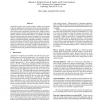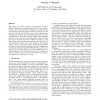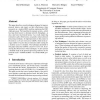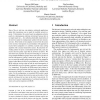SIGCOMM
1996
ACM
14 years 7 months ago
1996
ACM
Application-specific safe message handlers (ASHs) are designed to provide applications with hardware-level network performance. ASHs are user-written code fragments that safely an...
SIGCOMM
1996
ACM
14 years 7 months ago
1996
ACM
Prior work in the
eld of packet radio networks has often assumed a simple success-if-exclusive model of successful reception. This simple model is insucient to model interference...
SIGCOMM
1996
ACM
14 years 7 months ago
1996
ACM
This paper describes several techniques designed to improve protocol latency, and reports on their effectiveness when measured on a modern RISC machine employing the DEC Alpha pro...
SIGCOMM
1996
ACM
14 years 7 months ago
1996
ACM
The large-scale behavior of routing in the Internet has gone virtually without any formal study, the exceptions being Chinoy's analysis of the dynamics of Internet routing in...
SIGCOMM
1996
ACM
14 years 7 months ago
1996
ACM
State of the art, real-time, rate-adaptive, multimedia applications adjust their transmission rate to match the available network capacity. Unfortunately, this source-based rate-a...
SIGCOMM
1996
ACM
14 years 7 months ago
1996
ACM
There is much experimental evidence that network traffic processes exhibit ubiquitous properties of self-similarity and long-range dependence, i.e., of correlations over a wide ran...
SIGCOMM
1996
ACM
14 years 7 months ago
1996
ACM
Abstract-- We present a Start-time Fair Queueing (SFQ) algorithm that is computationally efficient and achieves fairness regardless of variation in a server capacity. We analyze it...
SIGCOMM
1996
ACM
14 years 7 months ago
1996
ACM
Conventional implementations of communication middleware (such as CORBA and traditional RPC toolkits) incur considerable overhead when used for performance-sensitive applications ...
SIGCOMM
1996
ACM
14 years 7 months ago
1996
ACM
Wormhole routing LANs are emerging as an effective solution for high-bandwidth, low-latency interconnects in distributed computing and cluster computing applications. An important...
SIGCOMM
1996
ACM
14 years 7 months ago
1996
ACM
Fast and flexible message demultiplexing are well-established goals in the networking community [1, 18, 22]. Currently, however, network architects have had to sacrifice one for t...




